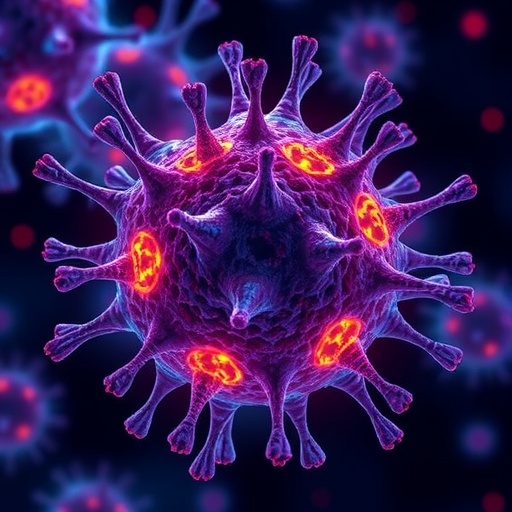In a groundbreaking advancement in cancer immunotherapy, researchers at Moffitt Cancer Center have engineered a pioneering biomaterial system designed to induce the formation of tertiary lymphoid-like structures (TLSs) within the body, offering a powerful new avenue to tackle tumors traditionally resistant to immune-based treatments. This innovative approach leverages a biodegradable hydrogel platform embedded with lipid-coated microparticles capable of releasing key immune-stimulating chemokines and cytokines in a controlled, sustained manner, effectively orchestrating a localized immune response that can mimic the tumor-fighting environments naturally found in certain cancers.
TLSs are specialized immune cell aggregates resembling lymph nodes that arise ectopically within tumors or chronically inflamed tissues. Their presence has been strongly correlated with enhanced patient survival and improved responsiveness to immunotherapy regimens, marking them as critical elements of effective antitumor immunity. However, the natural formation of TLSs is neither universal nor well understood, with many tumors demonstrating an immunologically “cold” microenvironment lacking these critical immune niches. The difficulty in replicating TLS formation and function in laboratory models has hampered efforts to study and ultimately harness these structures for therapeutic benefit.
To address this challenge, the Moffitt research team developed a sophisticated injectable hydrogel system composed primarily of chitosan, a biodegradable polysaccharide, integrated with meticulously engineered lipid-coated microparticles. These microparticles are loaded with a cocktail of immune signaling molecules that include chemokines — which recruit specific immune cell subsets — and cytokines — which activate and modulate immune cell behavior. Upon injection beneath the skin in murine models, the hydrogel slowly releases these bioactive factors, creating a chemotactic gradient that draws T cells, B cells, and antigen-presenting cells to the biomaterial interface.
This localized immune cell recruitment subsequently culminates in their self-organization into highly structured clusters that recapitulate critical architectural and functional features of TLSs observed in actual tumor sites. Histological and molecular analyses confirmed that these induced TLS-like structures closely mimic natural tertiary lymphoid organs, displaying segregated T and B cell zones, follicular dendritic cell networks, and germinal center-like areas crucial for adaptive immune responses. Importantly, the presence of these synthetic TLSs correlated with pronounced activation of tumor-specific T cells and significant attenuation of tumor progression in the treated mice.
The ability to engineer TLS formation on demand represents a significant breakthrough, as it not only facilitates detailed mechanistic studies into TLS biology but also offers a translational platform for therapeutic innovation. With many cancers currently lacking pre-existing TLSs and exhibiting resistance to checkpoint inhibitors and other immunotherapies, this approach provides a means to “warm up” cold tumors by constructing their own immune hubs. Enhancing this in situ immune environment could fundamentally change the landscape of cancer treatment by empowering endogenous immune cells to mount robust attacks against malignant cells.
Dr. Rana Falahat, the lead scientist on the project and a research expert in Moffitt’s Immuno-Oncology Program, emphasizes the transformative potential of this biomaterial strategy. She highlights the intersection of biomaterials science and immunology as a fertile ground for novel cancer therapies, noting that the precision release of chemokines and cytokines from the hydrogel sets in motion a highly orchestrated sequence of immune events that were previously difficult to replicate in vivo. This precision enables unprecedented control over TLS generation and function, which could unlock new immune mechanisms and therapeutic targets.
Beyond cancer, the implications of this research may extend to chronic infections and autoimmune diseases, where TLSs are also implicated. Understanding how to trigger or modulate these lymphoid-like structures could lead to treatments that either boost host defense against pathogens or suppress pathological immune activity. However, the immediate focus remains on translating these findings into clinical interventions for cancer patients, particularly those with tumors refractory to current immunotherapies due to the absence of TLSs.
The hydrogel-based approach offers several advantages over conventional methods of immune modulation. Its biodegradability ensures gradual resorption and minimal long-term foreign body effects, while the injectable format provides a minimally invasive means to initiate complex immune microenvironments in situ. The lipid-coated microparticles serve as effective reservoirs for sustained release, maintaining a localized high concentration of immune signals without systemic toxicity. This biomaterial platform demonstrates a refined capacity to emulate natural immune organogenesis ex vivo, bridging the gap between bench and bedside.
Current efforts are underway to further characterize the molecular pathways and cellular interactions underpinning TLS induction by the biomaterial system, aiming to optimize the composition and timing of chemokine and cytokine release. Additionally, researchers are investigating combinatorial approaches pairing the TLS-inducing hydrogel with other immunotherapeutic agents to maximize synergistic antitumor effects. Preclinical studies in more complex tumor models and eventually clinical trials will be critical next steps to evaluate safety, efficacy, and potential for integration into existing cancer treatment paradigms.
The study, published in the Proceedings of the National Academy of Sciences, was supported by prominent funding agencies including the National Cancer Institute and several philanthropic foundations dedicated to cancer research. This collaborative effort underscores the interdisciplinary nature of modern immuno-oncology research, merging materials science, molecular biology, and clinical oncology to innovate transformative therapies. The biomaterial system’s success heralds a new era where engineered immune microenvironments could be tailored to overcome tumor immunosuppression and harness the full power of the body’s defenses.
Ultimately, this research exemplifies a paradigm shift in cancer treatment strategies: moving from broadly acting systemic therapies to precise, localized immune engineering. By providing a scaffold for the body’s immune cells to coordinate their attack within the tumor microenvironment, the TLS-inducing biomaterial promises to convert previously unresponsive cancers into candidates for effective immunotherapeutic intervention. As research progresses, this technology could redefine the approach to cancer immunotherapy and offer hope for patients with hard-to-treat tumor types.
Subject of Research:
Article Title: Chemokine/cytokine-releasing biomaterials induce in situ tertiary lymphoid–like structures and enhance antitumor immunity
News Publication Date: November 6, 2025
Web References: https://www.pnas.org/doi/10.1073/pnas.2409560122
References: Proceedings of the National Academy of Sciences, 3-Nov-2025
Keywords: Immunotherapy, Tertiary lymphoid structures, Biomaterials, Cancer immunology, Hydrogel, Chemokines, Cytokines, Tumor microenvironment




